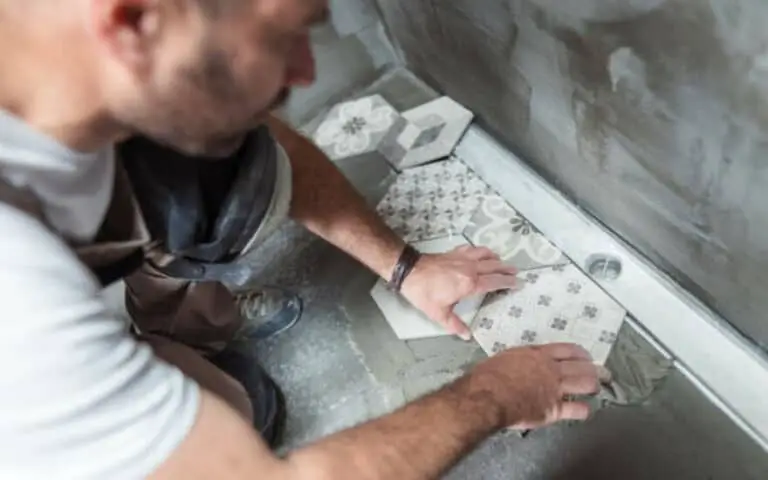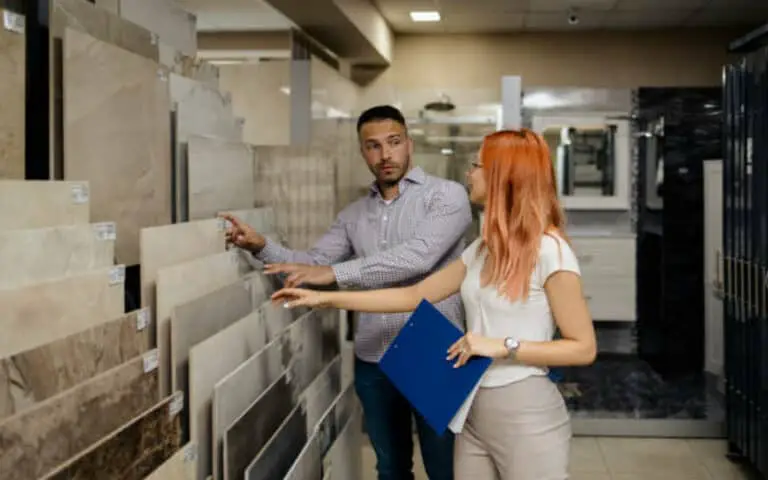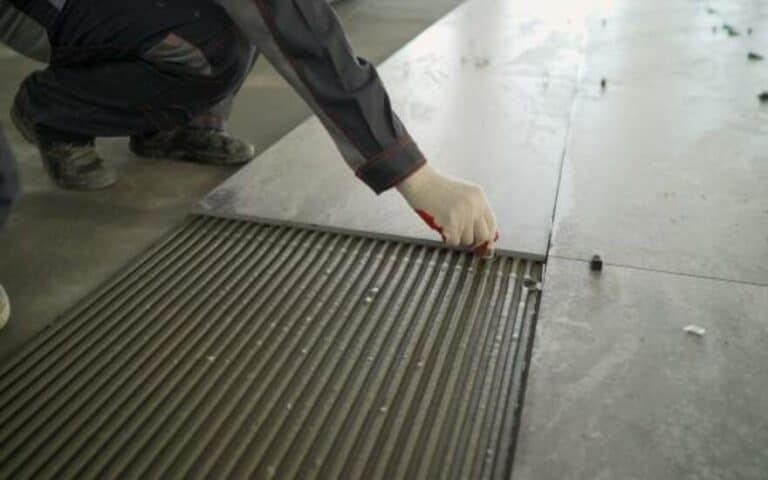Keeping your bathroom floor clean and looking its best is an important part of home maintenance. In this blog post, I’ll look at how to clean and care for various bathroom flooring materials.

Clean for Different Bathroom Flooring Materials
It’s important to understand the proper steps for each type of floor material to keep it looking its best.
1. Preparing a Bathroom for Cleaning
Before cleaning your bathroom floor, it is important to take the necessary steps to prepare the bathroom for cleaning. This includes clearing debris or loose dirt, dusting and sweeping the floor, and wiping down any surfaces with an all-purpose cleaner.
After this, you can start to clean the floor with the appropriate cleaning solution for your flooring material. Additionally, when using cleaning solutions, be sure to open the windows to ensure proper ventilation and to avoid any fumes that may be bothersome.
To finish off, use a damp mop and fresh water to remove any remaining traces of the cleaning solution. These steps ensure that your bathroom is properly prepped for cleaning and ready to be taken care of.
2. Cleaning Terrazzo Floors
When cleaning terrazzo floors, there are some specific steps you need to take. First of all, you should prepare your bathroom for cleaning.
Sweep and mop the floor regularly using a neutral cleaner such as Lithofin EasyCare. Make sure to use soft, even strokes to prevent streaking. Additionally, you should use a degreasing detergent diluted 1:10 with water and avoid all-purpose cleaners and vinegar.
You can also use a mechanical buffing machine on heavily soiled floors, but be sure to use a neutral cleaner such as Revitalize™ or Stone & Tile Cleaner. Finally, Rejuvenate offers a floor cleaning line specifically designed for terrazzo floors. With these steps in mind, you can keep your terrazzo floors clean and looking great.
3. Cleaning Vinyl Flooring
Vinyl flooring is one of the most popular choices for bathroom flooring, providing a durable and waterproof surface that is easy to clean and maintain. For regular cleaning, a broom or vacuum can be used to remove any loose dirt and debris.
For deeper cleaning, mix a cup of apple cider or white vinegar with a gallon of hot water and use a damp mop to apply to the floor, rinsing the mop frequently with clean, hot water from a bucket. For tough stains, use a vinyl flooring cleaner and a non-abrasive cloth.
Wipe up any excess liquid immediately and dry the floor before walking on it. Finally, use a doormat to help reduce the amount of dirt and debris tracked onto the floor.
4. Cleaning Ceramic Tiles
When cleaning ceramic tile, you should use mild detergent and warm water. Avoid using harsh chemicals or bleach, as these can damage the tiles.
To remove grease stains, use club soda and water or a commercial floor cleaner, and for ink stains, soak a cloth in diluted bleach and lay it on top of the stain.
For high-gloss porcelain tiles, it’s best to check with the manufacturer or installer to find a safe, neutral pH cleaner. Add a quarter cup of vinegar to your mop water for deep cleaning.
After cleaning, rinse any soap residue with plain hot water and dry the floor as soon as possible with a cloth or mop.
5. Cleaning Laminate Floors
When it comes to laminate flooring, cleaning and caring for it is relatively straightforward. Start by sweeping or vacuuming loose debris and follow up with a damp mop or cloth for a deeper clean.
It’s important to avoid using abrasive products or materials on the laminate as this could cause scratches.
To remove stubborn particles, use a vacuum cleaner with a hard floor attachment. Spot cleaning regularly helps keep your laminate looking great and prevents the need for deep cleanings.
For extra cleaning power, use a ratio of about 1 cup of rubbing alcohol to 1 gallon of water, and never introduce water to the floor until all dirt, crumbs, and other debris have been removed.
6. Cleaning Wood Floors
Wood floors add a unique, timeless look to any bathroom. While they require more maintenance than other types of flooring, with the proper cleaning and care, they can last for years.
You’ll need to sweep or vacuum up any loose debris. Then, you can make your floor cleaner by combining a teaspoon of clear, unscented dish soap with a gallon of warm water. When mopping, use a damp mop and avoid saturating the floor.
For untreated solid wood floors, it’s important to use a wood floor cleaner or an oil treatment to protect the wood from moisture and staining. Regular preventative maintenance is key to keeping your wood floors looking their best.
7. Cleaning Carpeted Floors
Cleaning carpeted floors is slightly different from cleaning other flooring materials, as it requires a bit more effort.
Carpeted floors need to be vacuumed regularly to remove dirt and debris, and it’s important to use a vacuum with strong suction to get a deep clean. If you’re looking for deeper cleaning, shampooing carpets are a popular way to do it.
Shampooing carpets also protect against dirt and stains and can help keep your carpets looking nice for longer. It’s important to ensure that you use a gentle cleaner and follow the directions on the package so you don’t damage your carpets.
8. Maintaining Regular Cleanliness
Maintaining regular cleanliness is the key to ensuring your bathroom floor stays in good condition.
It’s important to clean frequently, preferably at least twice a week. Start by preparing the room for cleaning by opening windows and ventilating the area. Different flooring materials require different cleaning techniques, so select the right mop for your floor type.
Use a rag or chamois-type mop with mild detergent and clean water for ceramic tiles. For laminate floors, use a dust or dry strip mop to remove hair and debris, followed by a multipurpose spray cleaner.
Terrazzo floors can be cleaned with mild detergent and warm water and should be sealed every two years. Vinyl flooring should be mopped with warm water and mild soap, while wood floors should be swept or vacuumed and cleaned with a damp mop.
Carpeted floors should be vacuumed regularly. Once you’ve finished cleaning, rinse the floor well and dry it to prevent damage from moisture.
9. Preventative Maintenance for Bathroom Floors
It is essential to ensure that your bathroom floors are well maintained to keep them looking good and performing their best.
Regular preventive maintenance will help you prolong the life of your flooring and keep it looking great for years to come.
This includes regularly sweeping and mopping with appropriate cleaning products, sealing grout lines, and ensuring that all spills are wiped up quickly.
Additionally, be sure to ventilate the room when cleaning to avoid damage from moisture, and use cleaning products specifically designed for the type of flooring you have. These steps will help keep your bathroom floors looking their best and prevent extra wear and tear.
Care for different bathroom flooring materials
Caring for your bathroom flooring is essential to ensure that it remains in good condition and lasts for many years.
Depending on the materials you’ve chosen, there are certain steps you should take to properly maintain your bathroom flooring.
Ceramic tile is a popular choice for bathroom floors as it is low maintenance and provides a slick finish. Regularly mop the surface with warm water and mild soap to keep cerathe mic tile looking its best.
1. Caring for Ceramic Tile
Caring for ceramic tile is not difficult but requires periodic maintenance. As with any other flooring type, it’s important to sweep or vacuum regularly to remove dirt and debris. You should also mop it with warm water and a mild detergent or tile cleaner.
You can use a diluted bleach solution for stubborn stains, but be sure to rinse the area with clean water afterward and dry it thoroughly. To maintain its shine, use a pH-neutral or mildly alkaline cleaner. Avoid harsh chemicals and opt for natural cleaners whenever possible.
2. Caring for Vinyl or Linoleum
Caring for Vinyl or Linoleum is not as difficult as it may seem. Sweeping and vacuuming to remove any debris and dust is a must.
This will help keep it free from allergens and mites. A damp mop with a product made for vinyl or linoleum works best for regular cleaning. You can also use a solution of one cup of apple cider or white vinegar per gallon of hot water.
Make sure to dampen the mop before applying the solution. Avoid using abrasive materials such as scouring pads, as they could damage the flooring. Use a cleaning agent specifically made for vinyl or linoleum floors to clean up tougher stains.
Regular maintenance and preventive care can help extend the life of your flooring and keep it looking great for years to come.
3. Caring for Natural Stone
Natural stone is a classic and timeless flooring option for your bathroom, and with the right care, it can last for decades. However, it is important to clean your natural stone flooring correctly and regularly to help maintain its beauty and lifespan.
Regular cleaning is essential to prevent dirt and debris from becoming embedded in the stone, which can cause etching or staining. To clean natural stone, use a pH-neutral cleaner specifically designed for stone and apply it using a mop, cloth, or sponge. After washing with the solution, rinse the surface thoroughly to remove any residue.
Summary
It’s important to keep in mind that the best way to keep your bathroom floor looking great is to practice routine cleaning and maintenance.
Regular sweeping and mopping can prevent dirt and debris from accumulating, leading to more serious issues like discoloration or damage. Additionally, preventative maintenance on your flooring will help ensure it looks its best for as long as possible.
Depending on your flooring type, this may include polishing, waxing, sealing, or other treatments. You’ll be rewarded with a beautiful and long-lasting finish by taking the time to properly care for your bathroom flooring materials.






